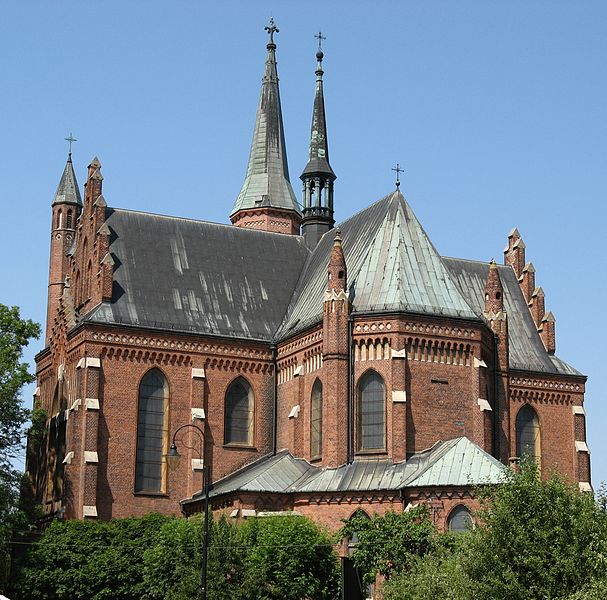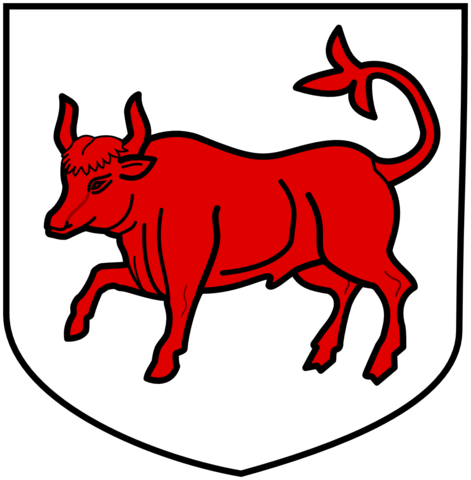Turek

Church of Jesus Sacred Heart in Turek. – Photo by: I, Piom, JHHChurch Turek PioM, CC BY-SA 3.0
Distance
Population
28.843 (2011)
Location and history
Turek is located in central Poland, northwest of Łódź. The county to which the town belongs is Wielkopolska with the county capital of Poznań. Turek is the second largest city in the Konin lignite district.
The first documented mention of the settlement occurs in a bun from Pope Innocent II in 1136. Here you will find the name “Turkoviste” as a designation for the later Turek.
During the Crusaders' attack on Turek in 1331, part of the city burned. Among other things. burned the wood-built church, in whose place a foundation walled church was erected, consecrated to John the Baptist. This church existed until the beginning of the 20th century. In 1341, Turek was granted commercial property rights, granted by Archbishop Janisław. The town was owned by the bishops of Gniezno from 1341-1796. Among other things, the diocesan administration meant that it was forbidden for all foreigners and all faiths other than Catholics to settle in Turek. From the time of the diocese, there have been several reports of witchcraft affecting women from the city and surrounding areas suspected of witchcraft.
Until the time of the Enlightenment, no significant development took place in the city. Thus, in 1458, Turek accommodated only 800 inhabitants and belonged to the group of small towns in the province of Wielkopolska. In the 15th year. agriculture was the most important profession. Only in 1515 did the town get its first annual market. In 1637 new rules came into force on local authorities, with Archbishop Jan Wężyk decreeing that at the head of the city council there should be a mayor elected by the star oost and two city council members.
As a result of Poland's second division, Turek joined the majority of Wielkopolska under Prussian rule. In 1796, a Prussian decree came that all ecclesiastical properties in Wielkopolska – including Turek – should be included under the Prussian state.
In 1807, the city was part of the Principality of Warsaw (in effect a French puppet state). When the Principality was dissolved in 1815, the city, along with the rest of the Kalisz area of the Kingdom of Poland, joined. This state was originally in personal union with the Russian Empire, but later it became part of Russia.
From 1820, Turek slowly gained the character of an industrial city. The city was modernized, several ground-walled houses were built, while the wooden buildings disappeared. A distillery and brewery were founded, a brickwork was opened and several companies started to complete textile products. From about 1826 weavers from the Czech Republic and Saxony began to settle in Turek, which meant a further development of the textile industry in the city.
During the November uprising of 1830 against the Russians, several people from Turek and the surrounding area also participated. As a result of reprisals from Russia due to the uprising, the textile industry declined, several weavers and others moved from the city and the population decreased from approx. 2,300 to approx. 2000. However, the textile factories still worked, but with a smaller production. In 1852 and 1866, the city was hit by a cholera epidemic; several hundred inhabitants perished.
In 1863, the January uprising erupted, in which Turek residents also participated. On January 1, 1867, the Russian authorities formed a District of Turek, which became part of the Kalisz Government (Kališskaja Gubernija). According to a Russian census of 1897 in the Kalisz Government, at that time 8,118 people lived in Turek. The number of weaving workshops in Turek was 358 in 1908.
Immediately after the outbreak of World War I in 1914, the Russian authorities left Turek, who was instead occupied by German forces. The Germans remained in the city until 1918.
In 1919, Turek residents participated for the first time in the legislative elections (Sejm Ustawodawczy). A Polish mayor of Turek was elected, Władysław Kaczorowski, who remained in his post until 1927. In 1924, the first issue of a local newspaper was published: Echo Tureckie.
On September 5, 1939, the city was taken by the German army and a few days later, on September 9, approx. 300 inhabitants shot by the Germans at the market square in Turek. The Germans created a ghetto in 1940, where approx. 5,000 Jews from the city and vicinity were gathered. All the streets of Turek were renamed and given German names. The Jews in the ghetto were taken away and subsequently murdered in the extermination camp in Chełmno nad Nerem (in German: Kulmhof). The camp has now been converted into a museum.
On January 21, 1945, the Germans were driven out of Turek by the Soviet army. Shortly thereafter, Polish authorities took control of the city. Now work began to rebuild and develop the business in the city. In 1951 a large silk factory was established “Miranda“that could be seen as a continuation of the traditional weaving industry in the city. The large deposits of lignite in the area were discovered in 1959. In the following years, considerable investments were made in the energy industry in Turek; the electricity plant and the coal mine “Adamow” created. In 1975 there are approx. 20,000 inhabitants of Turek. As a result of the first free municipal elections after the 1990 war, a 30-member city council takes over the Turek governorate.
Ludwik Grossman , Polish composer, conductor, pianist, organist etc., was born in Turek 6.3.1835, died in Wiesbaden, Germany, 15.7.1915.

Turek’s urban weapons depicting a bullet of uroxia. – Photo by: anonymous, Coat of Arms of Turek, CC BY-SA 2.0
The name of the city
The name Turek comes from “Trip“who, in Slavic mythology, was a giant unruly who lived in the interior of the earth and who with his horns could cause earthquakes. The word also covers the Polish meaning “aurochs” or “bull”. The name Turek thus means “the place where the Uroxes go”. The word “trip” or similar are found in several Slavic and Baltic languages and they have a connection with Latin “taurus” and the Greek “Tauros“that means “bull” or “ox”. However, one unrest was in Latin: “urus”, possibly of Celtic origin. Protokeltisk: “tarwo” meant a bull.
The turmoil is now extinct. The last unrest in Poland was killed in the 17th century.
Tourist attractions
Selected attractions:
The Church of the Sacred Heart of Jesus
is built 1904-1913 on the site of a former Gothic church building. The new church is in neo-Gothic style; it is a three-ship building where the main ship is slightly elevated and ends with a chorus. The interior and decoration of the church is particularly noteworthy in that it was performed by the excellent Polish artist Józef Mehoffer in the years 1933-1939.
Weaver houses
at omeromski Street was erected in 1820’in accordance with a uniform architectural plan. The houses were built over a rectangular floor plan measuring 15 × 8 meters and facing the street. The building material was bricks that were plastered. Each house contained two apartments, separated by a living room. The houses had saddle roofs covered with cardboard. Behind each building was a quite large garden where the weavers first erected small extensions and then weaving workshops.
City Hall
The former town hall is located at Plac Wojska Polskiego. The building was erected in 1867-1876 in a classicist style. Above the main entrance is a balcony and above it stands a watch tower. The watch dates from 1876 and beats neighborhood as well as hourly. Today, the building is the setting for the city museum as well as the city's tourist office.
The Evangelical-Augsburg Church
was built in 1849-1852 by drawings by architect Henryk Marconi; this was an Italian-Polish architect, born in Rome 1792 as Enrico Marconi, dead in Warsaw 1863. The church is built on a floor plan like a Greek cross and in a classicist style. The entrance to the church can be found in the center axis of the building and above the entrance is the bell tower.
Józef Piłsudski Memorial
performed by Józef Gosławski in 1936; a casting can be seen since 1990 in a park south of the center.
Józef Mehoffer’s memorial bench
A memorial bench is to be understood as a sculpture consisting of a bench on which sits a sculpture by Mehoffer. Józef Mehoffer was a prominent Polish painter, graphic artist, creator of mosaic tiles and was one of the most prominent representatives of the flow of art and literature called Młoda Polska (Young Poland). He was born in Ropczyce in 1869 and died in Wadowice in 1946. He was associated with Turek through his splendid decoration of the parish church, which is why he was also granted an honorary citizenship in the city. The sculpture stands at Plac Henryka Sienkiewicza.
The town of Turek’s Museum
The museum was formerly called Weaver Craft Museum, but has expanded its business and from 2012 changed its name to the City of Turek’s Museum. Here you will find an archaeological and general historical section, an ethnographic section, a special section on weaving crafts in Turek and finally an art department. The museum is housed in the former town hall.
Surrounding Area
The river Warta runs from the south to the north about 20 km east of Turek, where it forms a boundary on the Łódź county.
There are good road connections: Two main roads, numbers 83 and 72, as well as road # 470 meet at Turek. Furthermore, just 17 km north from Turek to the A2 (E30) motorway, which runs from Warsaw to the German border at Świecko.
About 20 km to the northeast lies the village of Chełmno nad Nerem with a museum of the former German concentration camp, called Kulmhof in German.
Accommodation
Booking.com
Turek – in Polish, English and German – with practical information for tourists
Eating Out:
Turek – in Polish, English and German
Other Internet sites and sources
Turek – in Polish, English and German
Translated into English by Google Translate. Spangshus.dk accept no liability for any errors or omissions in translation.
Map

Rating
Search
Most used tags
churches (205) Castles (86) Monasteries (79) Town walls (74) Lakes (71) Town halls (67) Rivers (65) Castles1 (62) Mansions (55) Museums (51) Regional museums (38) Town gates (36) Abbey churches (35) Castle ruins (30) Cathedrals (26) Forests (25) Health resorts (24) Water sports (23) Mounds (23) National parks (22)Click for all tags
Denne side er også tilgængelig på dansk. This page and contents is (c) Copyright 2018- www.spangshus.dk. Based on Inviator software by ISCA Software